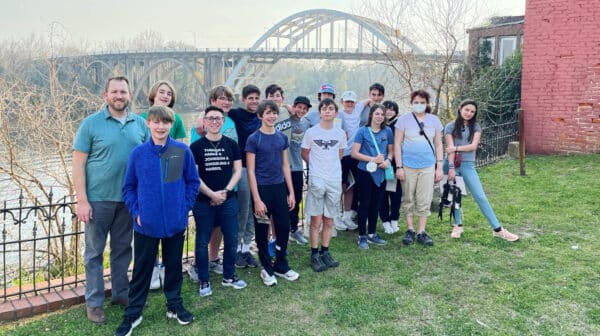Civil Rights Journey with Temple Teens

Welcome home to 15 of our Temple teens who have completed an unforgettable civil rights journey, visiting important sites throughout the South.
Here are some reflections from visits to Montgomery and Birmingham, compiled by Shira Stevenson, Director of Youth Engagement, who with Rabbi Dan Utley led the trip. Watch for more coverage in upcoming Temple publications.
Friday, March 4: Today we visited the Rosa Parks Museum in Montgomery, Alabama. We learned about the bus boycott and about voting rights. Jake shared that he loved the way the museum was set up to take us through the story. In the afternoon we traveled to Selma and met with JoAnne Bland who shared her story about her childhood in the civil rights movement and her time as a child advocating against voter suppression. She shared the story of trying to cross the Edmond Pettus Bridge to march to Montgomery three times. The first time, the marchers were attacked in the events known as Bloody Sunday. Sage reflected that, “it was impressive to learn the story of a woman who had been imprisoned 11 times by the time she was 13, just for being in marches.” Asher said, “it was awesome to talk to a person who was in such a big event.”
Chloe shared that, “Ms. Joanne’s story was really inspiring, and she had an impact on me because her personality was robust, not apologetic, and she was strong. We should always use our right to vote because past generations have fought for this human right.”
After the long day we gathered at the banks of the Alabama River – just west of the bridge to share Shabbat services with our friends from North Shore Congregation Israel in Chicago. Through prayers, songs, and silence, we reflected on what it means to pray in a place that has known violence and terror. As we heard many times – injustice is connected everywhere – from the streets of our cities, to large scale conflicts and war. For our groups it felt like an act of proud defiance to pray Jewishly out loud in such a location.
Saturday, March 5: Today we started our day early in Montgomery at the Equal Justice Initiative’s Legacy Museum. This new museum and education center that tells the important story of racism in America from slavery to mass incarceration. The museum contains many multimedia and emotionally powerful elements, not dissimilar from the experience of visiting the Holocaust museums.
Students were overwhelmed by the exhibits that described the sheer number of Africans who were shipped through east coast ports in the slave trade. Museum storytelling shared the experiences of being a slave, and the transition from slavery-reconstruction and eventually into Jim Crow laws. Perry reflected on how “powerful it was to listen to interviews of incarcerated people” at the exhibit that simulated a prison visitation.
From the museum, we traveled up the hill to the National Memorial for Peace and Justice which includes the display of over 4,000 names of black Americans who were killed by lynching from 1877-1950. Students remarked how sad it was to walk past and then beneath all of the hanging iron boxes that accounted for murders in Texas counties. The space at the memorial felt like holy ground and students paused to read and reflect on the poignant prayers and words on the walls, “We remember with hope because hopelessness is the enemy of justice.”
In the afternoon, we drove to Birmingham and met with Bishop Calvin Woods who shared his story of protests and violence in Birmingham during the movement. Bishop Woods recalled how Dr. King was like a prophet and how faith and God played prominent roles in their work for justice. We concluded by singing together and through a moving moment of prayer.
